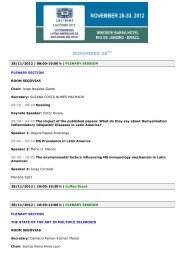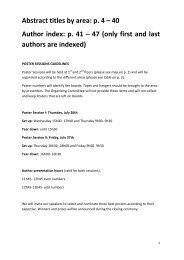Keynote Conference - Interevent
Keynote Conference - Interevent
Keynote Conference - Interevent
You also want an ePaper? Increase the reach of your titles
YUMPU automatically turns print PDFs into web optimized ePapers that Google loves.
Symp#24 Cancer<br />
Chair Renata Pasqualini<br />
Integration of in Vivo Phage Display & Targeted nanotechnology and Molecular-genetic Imaging<br />
Renata Pasqualini, Ph.D.<br />
The University of Texas, M D Anderson Cancer Center, USA<br />
Our group has previously reported the design, generation, and construction of AAV/phage (termed AAVP) particles (Hajitou et al.<br />
2006, Hajitou et al. 2007, Soghomonyan et al. 2007) for targeted molecular-genetic imaging. These hybrid vectors containing<br />
prokaryotic and eukaryotic cis-genomic elements have the potential to integrate ligand-directed targeting and molecular-genetic<br />
imaging. In a related line of research, we have used labeled, targeted peptide motifs themselves as imaging tools (Yao et al. 2005,<br />
Marchiò et al. 2004, Arap et al. 2004, Zurita et al. 2004, Cardó-Vila et al. 2003, Chen et al. 2003, Mintz et al. 2003). In pilot<br />
experiments, AAVP-based molecular-genetic imaging appears to be superior in side-by-side comparison to standard imaging because<br />
it provides prediction of therapeutic response in addition to only monitoring (Hajitou et al., PNAS, 2008). Thus, we plan to focus<br />
primarily on the development of AAVP-based molecular-genetic imaging approaches. Finally, we have also designed and developed<br />
nanotechnology-based (i.e., bottom-up self-assembled) biocompatible networks of phage-gold as nano-molecular sensors and<br />
reporters (Souza et al. 2006a, Souza et al. 2006b). This new methodology will be incorporated and will likely prove to be quite<br />
synergistic with AAVP (Souza et al. 2011). Here we used prototypes of this new class of targeted hybrid vectors for therapy and for<br />
molecular-genetic imaging, in conjunction to the discovery of new ligand motifs that target human tumor endothelium. AAVP-based<br />
anti-vascular cancer therapy by targeted TNF in pet dogs with native tumors has also been successful (Paoloni et al. 2009). Ultimately<br />
to generate an “imaging transcriptome” for human tumors. The incorporation of transcriptional targeting (through tissue-specific or<br />
radiation-induced promoters) to ligand-directed AAVP-targeting may enable one to determine a gene (or set of genes) status without<br />
tissue biopsy.<br />
Tumor Cell to Tumor Cell Interaction Drives Cancer Heterogeneity<br />
Webster K. Cavenee<br />
Ludwig Institute for Cancer Research, University of California San Diego, 9500 Gilman Drive, La Jolla, CA 92093-0660 USA<br />
Most efforts to understand the consequences of large-scale genomic mining of data from human tumors have focused on their cellintrinsic<br />
activities both in vitro and in vivo. Because of this, targeted therapeutic approaches have primarily been directed at features<br />
of individual tumor cells and their intrinsic mutations. For example, we have for more than a decade functionally dissected the<br />
amplification and mutation of the epidermal growth factor receptor gene (EGFR), that results in the common and oncogenic EGFRvIII<br />
(ΔEGFR) variant, a signature pathogenetic event in glioblastoma, the most common intracranial tumor. These analyses have allowed<br />
us to develop both small molecule- and antibody-based therapeutics that are now in clinical trials.<br />
Paradoxically, despite its greater intrinsic biological activity than wildtype EGFR (wtEGFR), only a minority of cancer cells in primary<br />
tumors possesses the hallmark ΔEGFR lesion, while the remainder expresses wtEGFR. We hypothesized that the ΔEGFR-expressing<br />
subpopulation has an extrinsic activity that provides enhanced tumorigenicity to the entire tumor cell population, perhaps through a<br />
paracrine mechanism. Using a combination of mixed tumor engraftments and biochemical analysis of paracrine factors and signaling<br />
pathways activation, we determined that human glioma tissues, glioma cell lines, glioma stem cells and primary mouse astrocytes,<br />
that express ΔEGFR each secrete IL-6 and/or LIF cytokines. This then prompts a novel interaction between the receptor that is<br />
common to these cytokines, gp130, and wtEGFR in neighboring cells that express amplified levels of EGFR, resulting in co-receptor<br />
activation and tumor growth enhancement. Ablating IL-6, LIF or gp130 uncouples this cellular cross-talk and potently attenuates<br />
tumor growth enhancement.<br />
These findings demonstrate that the heterogeneity that characterizes GBM, and perhaps other tumors with this feature, does not<br />
occur stochastically. Instead, it results from both intrinsic and extrinsic activities of driver mutations and can be an actively<br />
maintained feature. This illuminates for the first time a heterotypic cancer cell interaction of potential therapeutic significance.<br />
Targeting Adipose Tissue to Prevent Cancer Progression<br />
Wadih Arap, M.D., Ph.D.<br />
The University of Texas, M D Anderson Cancer Center, USA<br />
Human obesity is a leading cause of morbidity and mortality and a financial burden worldwide. Despite efforts in past decades, very<br />
few drugs have been developed for the treatment of obese patients. The paradigm of obesity treatment currently relies on CNS<br />
and/or peripheral metabolic mechanisms to suppress appetite and elevate energy expenditure, or inhibition of fat absorption. Only<br />
two Food FDA-approved drugs for weight loss are currently available in the United States (phentermine and orlistat); most<br />
unfortunately, placebo-subtracted weight losses are small and concerns over side effects limit their use, hence the great therapeutic<br />
challenge. Here we evaluated and validated a new conceptual approach against obesity: targeted induction of apoptosis in blood<br />
vessels supplying white adipose tissue (WAT). Our group is a pioneer in this area and has previously designed and has recently<br />
established adipotide as a prototype in a new class of drugs that target the vascular endothelium of white fat in pre-clinical models of<br />
obese rodents and obese non-human primates. We have chosen to pursue a pilot application of adipotide as a strategy to overcome<br />
the obesity-related tumor-promoting effects of obesity in the context of human prostate cancer progression and recurrence.<br />
Notably, we have received “safe-to-proceed status” from the FDA for the IND application of adipotide; as such, the start of the firstin-human<br />
clinical trial in obese prostate cancer patients is imminent. Our Specific Aims are: (i) To define the metabolic and oncologic<br />
consequences of targeted treatment with adipotide in obese men with prostate cancer. (ii) To lead optimize adipotide derivatives<br />
and dose-limiting toxicity in rodents and non-human primates. In the short-term, imaging guided studies will enable the rapid<br />
translation and drug lead optimization of adipotide and will provide the clinical foundation for approval of an entirely new approach<br />
against human obesity. In the long-term, a successful innovative therapy such as adipotide against human obesity would truly be<br />
transformative with immense public health impact against not only obesity but also against associated patient co-morbidities<br />
including diabetes, metabolic syndrome, arterial hypertension, atherosclerosis, and cancer.<br />
76





